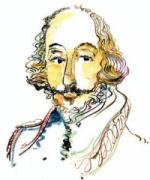|
This section contains 8,261 words (approx. 28 pages at 300 words per page) |

|
SOURCE: "Swan in Love: The Example of Shakespeare's Sonnets," in Between Men: English Literature and Male Homosocial Desire, Columbia University Press, 1985, pp. 28-49.
In the following essay, Sedgwick distinguishes between homosocial bonding and homosexuall desire in the sonnets. Asserting that the poems depict male-male love in the context of social institutions that confirm men's power and hegemony, she maintains that the Dark Lady represents a disruptive force that threatens to emasculate the speaker and destroy the homosocial bonds between the poet and the youth.
"A man is not feminized because he is inverted but
because he is in love."
Barthes1
. . . I would like to look briefly at Shakespeare's Sonnets. They are one of the two nonnovelistic texts that will frame this study (Leaves of Grass is the other), and I was attracted to them for similar reasons: both texts have figured importantly in the formation of a specifically...
|
This section contains 8,261 words (approx. 28 pages at 300 words per page) |

|


